IAEA discovers hundreds of holes in Chornobyl sarcophagus: Radiation threat or not
 IAEA discovers hundreds of holes in Chornobyl sarcophagus (Photo: Vitalii Nosach, RBC-Ukraine)
IAEA discovers hundreds of holes in Chornobyl sarcophagus (Photo: Vitalii Nosach, RBC-Ukraine)
After a Russian drone attack in February, more than 300 holes were discovered in the sarcophagus of the Chornobyl Nuclear Power Plant. The International Atomic Energy Agency (IAEA) has already determined whether there is a risk of radiation leakage, states the Director General of the IAEA, Rafael Grossi.
According to Grossi, investigations are ongoing at the Chornobyl Nuclear Power Plant to assess the extent of the damage caused to the sarcophagus after the drone attack in mid-February.
"It took several weeks to completely extinguish the fires caused by the strike. The emergency work resulted in approximately 330 openings in the outer cladding of the NSC arch, each with an average size of 30-50 cm," stated the IAEA.
What is damaged due to the strike
According to information provided by the IAEA team on-site, the preliminary assessment of the structural integrity of the large arched building revealed significant damage, including:
- panels of stainless steel on the external cladding,
- insulation materials,
- a significant portion of the membrane located between the layers of insulation materials designed to prevent the entry of water, moisture, and air.
Additionally, the IAEA team was informed that the main crane system of the sarcophagus, which includes the northern garage area for crane maintenance, was damaged as a result of the drone strike and is currently non-operational.
The crane maintenance garage is one of the key systems of the building. Several electrical cabinets for different systems are located in the garage area, most of which were damaged during the drone incident and from the water used to extinguish the fires caused by it.
What is working properly at Chornobyl
Other systems of the New Safe Confinement (NSC), which provide critical safety functions such as radiation monitoring, seismic monitoring, decontamination, radioactive waste management, power supply, and fire protection, remain operational.
At the same time, it was noted at the Chornobyl site that, despite the heating, ventilation, and air conditioning systems remaining functional, they have not been operating since the drone incident.
"We are gradually getting a more complete picture of the severe damage caused by the drone strike. It will take both considerable time and money to repair all of it," said Grossi.
Is there a radiation threat
IAEA also emphasized that a more reassuring factor is that no increase in radiation levels has been observed at the Chornobyl Nuclear Power Plant, indicating the absence of radioactive material release as a result of the strike.
Strike on Chornobyl on February 14
On February 14, Ukrainian President Volodymyr Zelenskyy reported that Russian forces struck the Chornobyl Nuclear Power Plant with a drone carrying a fragmentation warhead.
He immediately noted that the damage to the shelter was significant.
Later, photos of the aftermath of the drone strike on the plant emerged.
It should be noted that the emergency at Chornobyl was only resolved on March 7.

